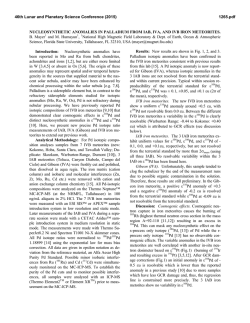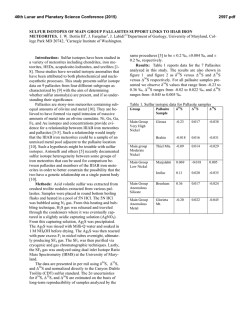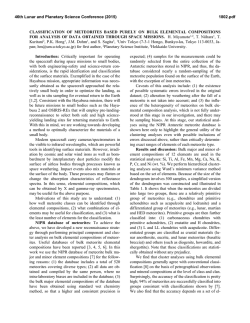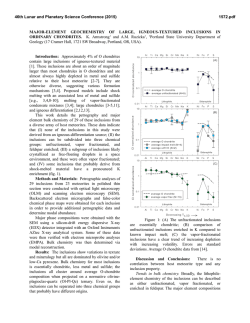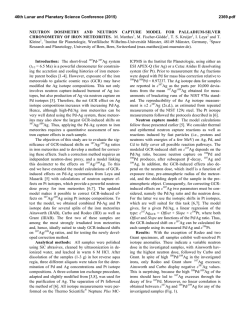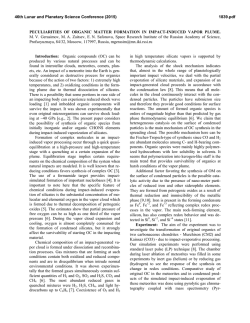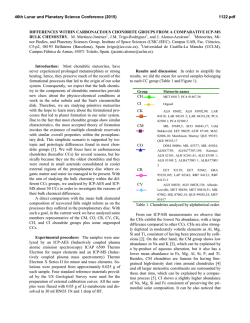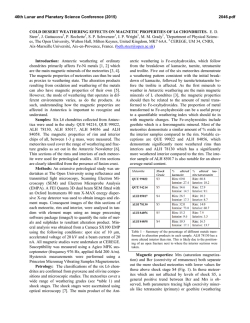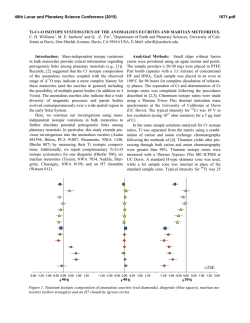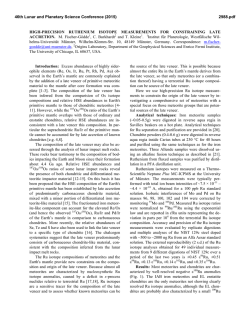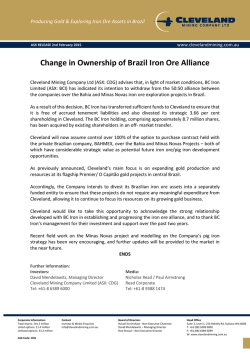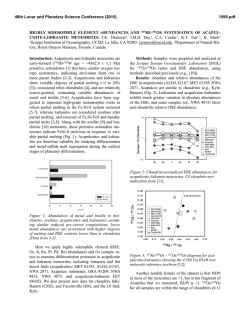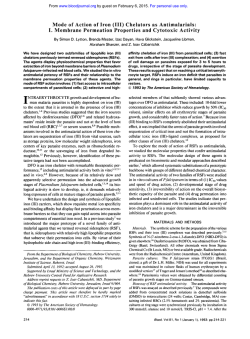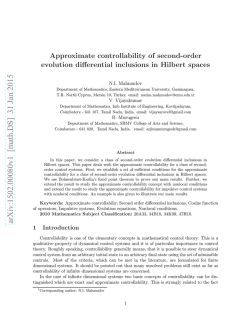
Study of Inclusions in Iron Meteorites, Cr
46th Lunar and Planetary Science Conference (2015) 3013.pdf STUDY OF INCLUSIONS IN IRON METEORITES, Cr-BEARING SULFIDE INCLUSIONS IN IVA IRON METEORITES. J. Isa1, K. D. McKeegan1, and J. T. Wasson1. 1Earth, Planetary and Space Science, University of California, Los Angeles. CA 90095-1567, USA. [email protected] Introduction: Although both “magmatic” and “nonmagmatic” iron meteorites mainly consist of Fe-Ni alloys; some sulfide, phosphide, graphite, nitride or silicate inclusions can be found in most iron meteorites ranging in size from less than one micron up to several cm. These inclusions contain potentially important information about their parent bodies and relationships to other meteorite groups in both magmatic and nonmagmatic iron meteorites. For example, using the silicate inclusions, several researchers have tested relationships between iron meteorites and stony meteorites mainly based on O-isotope compositions [e.g. 1]. In another study, the presence of S, P and C in iron meteorites was shown to play an important role in controlling elemental partitioning between solid and liquid metal [e.g. 2]. We utilized inclusions as a source of information to discuss effects of volatile elements on magmatic crystal fractionations. To begin with, we extended on prior research [3-5] by searching for Crbearing inclusions in IVA iron in the hope of discovering the phases that control bulk Cr concentrations and volatile abundances during fractional crystallizations. Based on these preliminary petrological observations and bulk chemical compositions, we hope to further investigate volatile oxygen enriched iron meteorites. Samples: We selected seven IVA meteorites that are chromium enriched (340-655 µg/g): Gibeon, Longchang, Maria da Fé, Maria Elena (1935), Obernkirchen, Santiago Papasquiero, and Social Circle. Individual sample sizes were about 500-600 mg. The samples had already been analyzed by INAA that was carried out at either the ARGONAUT reactor at the University of California, Los Angeles (max flux 1.5×1011 n/sec•cm2) or the TRIGA MARK I reactor at the University of California, Irvine (irradiation flux 8×1011 n/sec•cm2). The samples had been stored for 10 to 40 years after the INAA irradiation. We used two different ways to select inclusions: one by making thick sections and by the other dissociation of Fe-Ni metal. In general, chromite (FeCr2O4) and other chromium-bearing minerals are trace minerals in iron meteorites and are known to be insoluble during acid treatment. However, Fe-Ni metal, which constitutes the main component of iron meteorites, is soluble in weak acid. Analytical methods: Chromium bearing grains were identified from BSE images by using the SEM; the phases were analyzed by using EDX. BSE images were taken with a Tescan SEM. Cr-bearing inclusions were both located and analyzed using the EDX invariable pressure mode on the residue from the acid treatment. EDX was also used for locating Cr-bearing inclusions in the thick sections. Results: We observed Cr-bearing sulfide inclusions in 6 out of 7 IVA iron meteorites. In previous petrological studies, the occurrence of chromite was suggested in several IVA iron meteorites: Duchesne, Duel Hill (1854), Harriman (Of), Hill City, Mart, Altonah, Chinautla, Gibeon, Smithland, Social Circle, New Westville, Para de Minas, and Putnam County [3-5]; they were normally associated with troilite. However, we did not observe chromite inclusions in thick sections or in the residue from the acid treatment. The Crsulfide inclusions are mostly euhedral to subeuhedral and are discrete from other sulfide inclusions. It is plausible that the euhedral inclusions formed primarily from metallic melt. Remarkably, troilite inclusions were absent. The occurrence of exsolution lamellae observed in previous studies [5] was unclear. Discussions: Cr is known to be one of the anomalous elements during fractional crystallization. This is largely because experimental results have not been able to accurately predict or account for Cr compositions in bulk iron meteorites. Experimentally determined partition coefficients of Cr are very small, and yet Cr behaves as if it is compatible in bulk iron meteorite. The observed bulk Cr abundance is negatively correlated with bulk Au abundances, for example (Fig. 1). Therefore, determining the Cr-bearing phases is important because they can mainly control the Cr concentrations in solid metal and liquid metals. In the previous studies, this odd behavior was explained by heterogeneity distributions or extraction of chromite grains from metallic melt [6, 7]. However, observations of chromite inclusions were very rare in IVA iron meteorites, but euhedral sulfide inclusions were common (especially in Cr-enriched samples). This difference is important because the occurrence of primordial chromite or of daubréelite (FeCr2S4) restricts the ranges of temperatures, fO2 or fS2 during the fractional crystallization. Also, this observation explains the presence of elevated Cr concentrations in Au-poor samples. In contrast to this study, chromite was found in the low bulk Cr-content meteorites in the previous studies (Fig. 1). Although the chromite grains were found in Social Circle and Gibeon in the previous studies, we failed to locate chromite in our samples. These discrepancies may be due to sampling bias. Gibeon was found in several studies to have both chromite and daubréelite inclusions [3, 5]. The previous study [5] observed coex- 46th Lunar and Planetary Science Conference (2015) istence of daubréelite and chromite; the presence of these phases allows the estimation of sulfur and oxygen fugacities under the equilibrium. Cr-bearing sulfide occurs in low fS2, and troilite occurs in higher fS2 in the isothermal condition [8]. The presence of euhedral Crbearing sulfide textures (Fig. 2) that lack troilite indicate direct precipitation from melt under the low fS2 conditions in Au-poor samples. It should be noted that fS2 increase with progression of fractional crystallization as well as fO2. As a result, troilite coexisting with Cr-bearing sulfide or chromite inclusions occur in Aurich samples as observed in previous studies [3, 5]. Heterogeneous chromite precipitation may have caused the rapid change in Cr concentrations of the melt. Summary: Cr-bearing sulfide inclusions were common in IVA iron meteorites. We failed to locate chromite in our samples. The Cr-enriched compositions in Au-poor samples were due to the occurrence of Cr-bearing sulfides present in micron grains. These Cr-bearing sulfide was precipitated by cooling melt or via increasing fS2. Increasing fS2 together with fO2 during fractional crystallization results in chromite precipitation with troilite. Therefore, we predict that the sample crystalized in the late stage and should contain more oxide inclusions. The sample should be suitable for volatile element study such as studies focusing on oxygen isotopes. References: [1] Clayton and Mayeda 1996 GCA 60, 1999-2017, 3013.pdf Fe-free Cr-bearing sulfide silica rust 20 µm Cr [2] Jones and Drake 1983 GCA 47, 1199-1209 [3] Buchwald, 1975 University of California Press [4] Bunch and Keil 1971 The Am. Min. 56 [5] Petaev LPSC abstract 1997, [6] Wasson 1999 GCA Vol 63 Nr 7/8 1219-1232, [7] Chabot et al. 2009 MAPS 44, Nr 4, 505– 519 [8] Rahmel et la. 1987 Oxidation of Metals Vol, 27 Nr 3/4. 199220. Fe Fig. 1: Bulk Au and Cr abundance in IVA iron meteorites. Filled circles are samples from this study. Open triangles indicates bulk abundances of these elements in chromite observed samples in a previous study [4]. The bulk chemical data are from Wasson (personal communications). Fig. 2: BSE image and x-ray maps of rhombus shaped Cr-bearing sulfides inclusions from Maria da Fé. The inclusion was separated by acid treatment and surrounded by rust. The low Fe and high Cr content at the left corner probably indicate Fe free Cr-bearing sulfides.
© Copyright 2025
